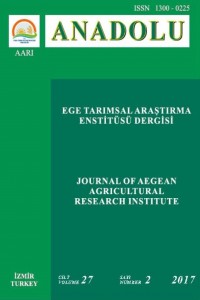Abstract
Although wild
species, landraces and species diversity play an important role in global food
security and are necessary for food safety and nutrition, they are very rarely
included in daily diets. The "Biodiversity for Food and Nutrition"
project, which aims to ensure sustainable use of agricultural biodiversity, was
carried out in three pilot sites in Turkey. As part of the project,
Kastamonu, Samsun and Sinop provinces were
chosen as the pilot sites in the Black Sea
Region. At the beginning of the project, ten wild edible species and a landrace
were identified by the pre-surveys performed at the Black
Sea pilot site. The samples of the species were collected from at
least ten locations and analyzed to determine their nutritional content. Most
of the wild edible species found to be intensively consumed in the Black Sea pilot site are rich in minerals, vitamins and
fiber. Preliminary surveys were
conducted to obtain socio-economic information and traditional knowledge on
wild edibles. The monograph technique was used and detailed data were collected
using questionnaires. The surveys were conducted by collecting species and
meeting face-to-face with collectors and consumers. Questionnaires were
administered to a sample of 111 collectors and 295 consumers. The survey
results showed that the most well-known and consumed wild edible species in
Sinop and Kastamonu is Kaldirik. Most of the consumers stated that they consume
wild species once or twice a week. Preparation of necessary policies and
legislation will be addressed on the basis of knowledge that was obtained from
this project. Awareness-raising activities will be held with the stakeholders
to strengthen the sustainable use of these species.
References
- Anonymous. 2014. FAO Gene Bank Standards. (http://www.fao.org/3/a-i3704e.pdf).
- Guzelsoy, N. A., O. Ucurum, E. Tokat, A. Tan, S. Tugrul Ay, K. Ozbek, and I. Ozkan. 2015. Nutrient content of selected biodiverse food in Turkey. 11th International Food Data Conference (IFDC) 3-5 November, 2015 Hyderabad, India.
Abstract
Yabani yenilebilir
türler, yerel çeşitler ve tür çeşitliliği küresel gıda güvenliği ve beslenme
için hayati önem taşısa da günlük beslenmemizde oldukça az yer tutmaktadır.
Tarımsal biyoçeşitliliğin sürdürülebilir kullanımının sağlanmasını amaçlayan
“Gıda ve Beslenme için Biyoçeşitlilik projesi” Türkiye’de üç pilot alanda
yürütülmektedir. Bu amaçla Karadeniz bölgesi çalışma alanı için Kastamonu, Samsun ve Sinop illeri
seçilmiştir. Projenin başlangıcında, Karadeniz bölgesinde yapılan ön
çalışmalarla on yenilebilir yabani tür ve bir adet yerel çeşit seçilmiştir. Bu
türler besin içeriklerinin belirlenmesi için en az on noktadan toplanmıştır.
Analiz sonuçlarında Karadeniz’de yaygın olarak tüketilen türlerin çoğunun
mineral, vitamin ve lif açısından zengin olduğu görülmüştür. Hedef türlere ait
sosyoekonomik ve geleneksel bilgilerin elde edilmesine yönelik ön araştırmalar
yapılmıştır. Anketlerde monografi tekniği kullanılarak detaylı bilgi elde edilmiştir.
Toplama ve anket çalışmalarında toplayıcı ve tüketicilerle yüz yüze görüşmeler
yapılmıştır. Anket çalışmalarında toplam 111 toplayıcı ve 295 tüketici ile
görüşülmüştür. Yapılan çalışmalar sonucunda Sinop ve Kastamonu’da en çok
bilinen ve tüketilen yabani yenilebilir türün Kaldirik olduğu anlaşılmıştır.
Çoğu tüketici yabani yenilebilir türler haftada bir iki kez tükettiklerini
ifade etmişlerdir. Gerekli politika ve mevzuatın hazırlanması konusu bu
projeden elde edilen bilgilere dayanarak ele alınacaktır. Bu türlerin
sürdürülebilir kullanımını güçlendirmek için paydaşlarla birlikte
bilinçlendirme faaliyetleri düzenlenmektedir.
Keywords
Yabani yenilebilir yerel çeşit biyoçeşitlilik beslenme geleneksel bilgi siyez Karadeniz Bölgesi
References
- Anonymous. 2014. FAO Gene Bank Standards. (http://www.fao.org/3/a-i3704e.pdf).
- Guzelsoy, N. A., O. Ucurum, E. Tokat, A. Tan, S. Tugrul Ay, K. Ozbek, and I. Ozkan. 2015. Nutrient content of selected biodiverse food in Turkey. 11th International Food Data Conference (IFDC) 3-5 November, 2015 Hyderabad, India.
Details
| Primary Language | English |
|---|---|
| Journal Section | Research Articles |
| Authors | |
| Publication Date | December 15, 2017 |
| Submission Date | October 2, 2017 |
| Published in Issue | Year 2017 Volume: 27 Issue: 2 |

